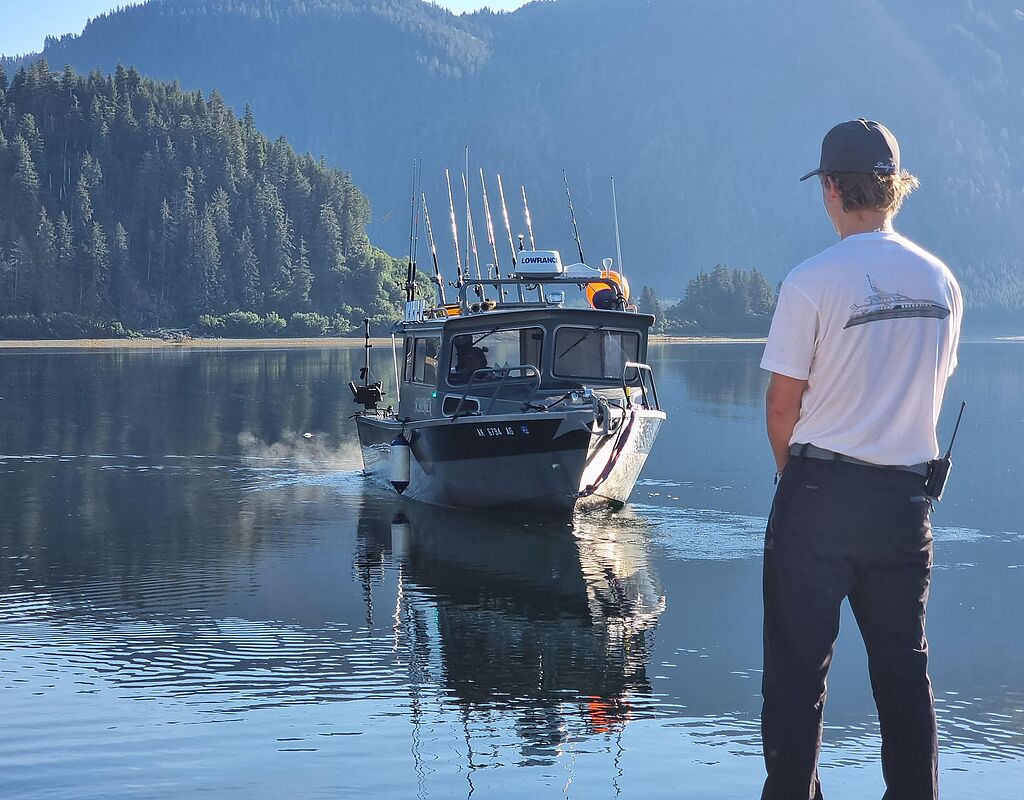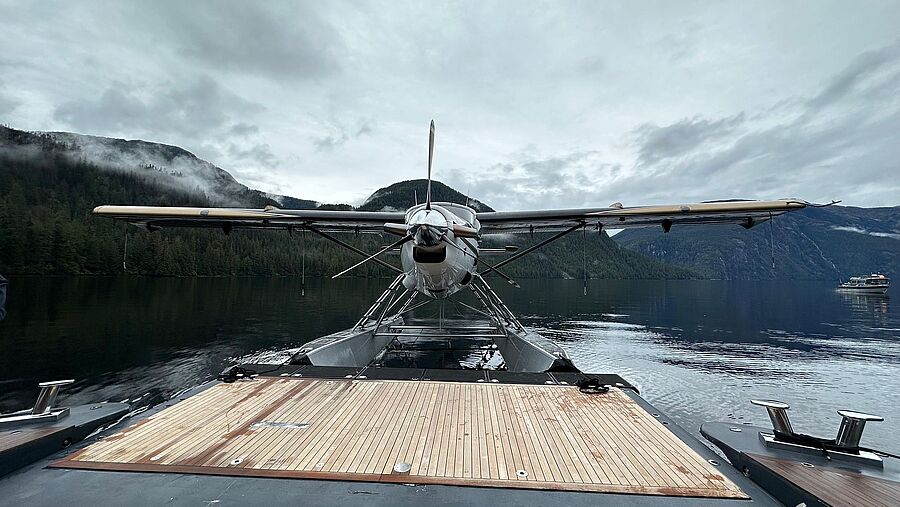North to Alaska
The remote inlets and islands of Alaska are a backdrop to some of the most spectacular scenery and wildlife in the world – and it is all in range for a superyacht.
“If I could buy a place out in Alaska, I would,” says Matt Davies. The captain of the 44m Lady L has cruised there for three seasons and says it is a wilderness like no other on earth.


The sights and experiences are rich and vast in scale. In the summer season, it is home to a huge range of rare wildlife. Few places in the world can boast such a diversity of whales, dolphins and porpoises, for example. From April to September fin whales, grey whales, orcas, blue whales, sperm whales, minke and humpbacks migrate to the abundant feeding grounds of Alaska’s cool waters and protected fjords and inlets, and can be seen almost everywhere along the coast.
It is a birdwatcher’s paradise: albatross, shearwaters, fulmars and petrels, auklets and guillemots all breed here. The sight of enormous bald eagles, with wingspans over 2m, is commonplace. Brown and black bears hunt along the forested shorelines of remote inlets, otters can be seen swimming near shore or floating on their backs gnawing at salmon. The backdrop is one of temperate rainforest, dark and brooding bays, waterfalls, hot springs and glaciers. Exploring it is like being in the midst of an epic nature documentary.
See bears, birds and glaciers
The route into Alaska by sea begins from the Inside Passage of British Columbia, leaving Canada and clearing into the US in the southeast Alaskan town of Ketichikan. The most popular routes wind north from there. Yachts either go up through the Chatham Strait, behind the protection of Baranof and Chichagof Islands, to the ice fields of Glacier Bay, or through the Stephens Passage via Tracy Arm and the many inlets of Admiralty Island, to the city of Juneau, before returning south on the reverse route.
The opportunity to get close to glaciers is a highlight of cruising in Alaska. Glacier Bay park opens up into a huge area of glacial fields with a hinterland of rugged mountains, fjords and rainforest covering over 3 million acres.


There are over 1,000 glaciers in Glacier Bay, and several stretch right to the sea. Most have been thinning and slowly receding over the last few decades, incontrovertible evidence of the cumulative effects of global climate change. Snowfall in the icefield sources has decreased, winters have become warmer and there has been a general reduction in cloud cover during the summer.
The Johns Hopkins Glacier is one of the few tidewater glaciers still advancing, but the Muir Glacier, once the major attraction of the Bay, is no longer a tidewater glacier at all. As recently as 1979, it flowed towards the sea at over 5m a day, but in 1993, it receded into the Muir Inlet so far it became a terrestrial glacier and remains so today.
“One of the strangest experiences is looking at charts that were surveyed 30 or 40 years ago and seeing how, back then, there was a glacier there. On the chart, it looks like you’re driving on land yet you're still in 300m of water,” says Matt Davies.
Caution with currents and driftwood
Navigation in Alaska can be exacting, Davies points out. “Fog can happen anytime really but in August especially it can get pretty bad. That is definitely a scenario that most yacht crew find themselves in so it’s what we talk about and it’s what we train for.”
The strong currents in the straits and narrows that separate the islands are also a factor to consider. These streams can run at up to 10-12 knots at springs, so careful passage planning is essential.
Driftwood is another consideration. “Seeing driftwood is a daily occurrence in British Columbia, and we did see some on the way out of Ketchikan too,” he says. It keeps you on your toes.” In mid-June, daylight stretches from 0400 to 2230, and even by the start of September, as the season is ending; it runs from 0600 to 1930. “You do get long days there in summer and that really does help with covering the distance and finding the right tidal windows,” comments Davies.
Pilot and passage plan required
Because of the particular challenges of cruising in this region, superyacht owners and captains have to keep in mind some essential formalities and restrictions. To provide insurance, Pantaenius requires the captain or a professional expedition company to provide a detailed passage plan including ports of call and anchorages.
Details of the experience of the captain and crew are needed, as well as of any ice pilot appointed. State regulations require vessels under 500GRT to have a pilot on board when they enter Alaskan Waters and for passages through the Peril Straits between Juneau and Sitka, and through the Wrangell Narrows. Vessels over 500GRT need to have a pilot on board whenever they are moving. Occasionally the State of Alaska may provide a yacht with an exemption if the captain is experienced in cruising in Alaskan waters.
Equipped with evidence that the yacht’s insurance covers pollution liability, the captain or yacht management company can then apply for a Certificate of Financial Responsibility (COFR); this is state requirement for navigating in Alaskan Waters.
“Once we have this, our risk assessment team will review the details,” says Michelle Van der Merwe, Pantaenius Superyacht Account Manager. “If all is in order, we advise on an additional premium applicable plus a higher deductible when cruising in Alaskan waters, mainly for the fact that there are very few yacht repair facilities in this area and therefore the claim costs would be higher than in a traditional cruising ground.
“We would then add a condition on the hull policy to confirm the dates of cruising in Alaskan waters, and apply a clause that excludes all scratching and denting to the paint and finish of the vessel’s exterior caused by fixed, floating or drifting sea ice, or any collision with an iceberg or growler. However, structural damage to the hull would remain insured.

Good shore support
This process may sound complicated, “but it is not difficult to achieve for an owner of a private yacht,” says Peter Butz, COO of superyacht expedition and yacht management company EYOS.
“Access to certain areas need a permit in advance. Glacier Bay has a cap on number of vessels that can visit, though that is easier for private individuals than charter vessels. Pack Creek on Admiralty Island and Anan Creek [south-east of Wrangell], where you can see brown and black bears, need permits as they have a limited number of visitors per day. But these are all pretty well protected waters with some real highlights and good shore support where that may be needed.”
Despite Alaska’s remoteness, it is relatively easy for guests to join for shorter visits or to enjoy an extended cruise. They can fly into one of the main Alaskan airports at Ketchikan, Juneau or Sitka, and then take a floatplane out to the yacht.
‘Flightseeing’ trips are also popular. “Guests take a floatplane for the day and come back and land right next to the yacht, and we pick them up in the tender. It’s a really neat experience,” says Davies.


Alaska’s quiet anchorages and temperate climate may not be for everyone. In June, the average high is 17°C. Towns are few and widely spaced. “I think it takes a certain kind of person to enjoy it,” observes Matt Davies.
“For those who enjoy the hubbub of cities, it might not be their scene, but for anyone who enjoys nature, it’s probably everything they would love about yachting and the world in general. The road systems here are very limited, so if you don’t come by boat then you are selling your trip short.”
